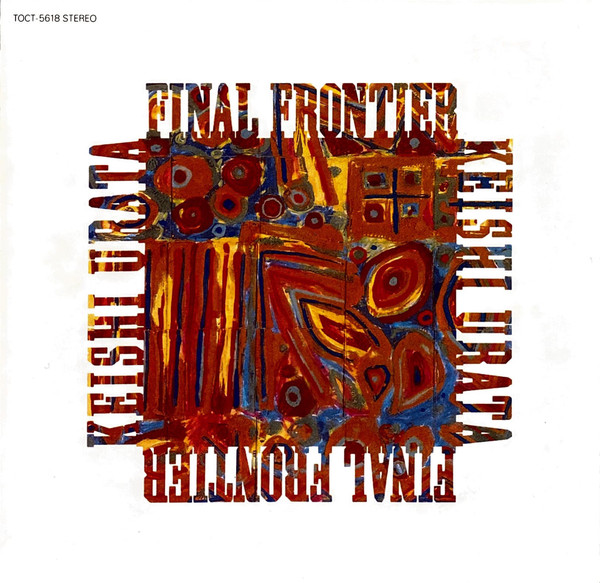
Talk about worlds within worlds. Isn’t that the essence of Keishi Urata’s 世界の果て (Final Frontier)? It’s about combining electronically-imagined sound atmospheres with otherworldly IRL, acoustic instruments. It’s about exploring the edges of jazz, ambient, and traditional music for an imaginary soundtrack to imaginary environs. It’s a work full of mystery from a man whose whole career is defined by a certain mystique.
At the time of the recording of 世界の果て (Final Frontier), Keishi was at a crossroad. One side, he could continue in the shadows as an indemand synth programmer and keyboardist for various Japanese pop acts, or he could elsewhere, pursue something that aimed closer to his original creative vision. Would his solo works speak to current trends or would it look forward, as much as his earlier work with Aragon did?

You see, when he was younger, Keishi’s step into music came not from music itself but the promise of sound design. He came into making music late in his life. It wasn’t until the age of 19 that Keishi touched his first keyboard. When he played a Mellotron (that early, sample-based playback instrument), Keishi’s noggin instantly recognized that he could conjure up a whole orchestra of instruments simply by changing a setting. It wouldn’t be until Keishi bought his first Moog modular synth that he began to chart a new path few in Japan understood then.
It was in the early ‘70s that Keishi took it upon to decipher and literally/physically untangle the way of synthesizing sound (through that first Moog). As he grew into an expert sound designer patching his way through that instrument, Keishi developed a reputation among Japanese session musicians and performing artists. If you can dream of a sound: Keishi would create it. So as music technology advanced, so too did Keishi stay one step ahead of the curve deeply involving himself in burgeoning gadgetry like computer-based recording, digital synthesis and sampling.
Keishi’s first studio gigs would be to perform as a keyboardist alongside would-be huge stars like Yumi Matsutoya, Hiromi Go, and Anri. On record one could hear his sound design gracing the work of Toshiki Kadomatsu, Akira Inoue, and Yoshitaka Minami. It was in the course of all this steady studio work that he befriended fellow studio musicians, Tsuyoshi Kon, Tadashi Namba, and Tatsuo Hayashi.
Keishi would help found the group, Aragon. Together with vocalist Kazuhiro Nishimatsu they’d use all the music technology they had at their disposal in the mid ‘80s to create music that hemmed and hawed through myriad disparate influences they all shared (and wanted to explore). Under the influence of prog, new wave, punk, art rock and hoping to touch on homegrown traditional music, Aragon’s first work presented an otherworldly blend of forward-thinking pop music that sounded like little else in Japan at the time.
That fascinating left-turn into creating forward-thinking pop music would allow Keishi to understand that his talents could be off use in a realm that could be a third way marrying the experimental, traditional, and contemporary. In the late ‘80s an opportunity to join Geinoh Yamashirogumi afforded him the ability to pursue this exploration even further. All the overground work he had done for others had begun to manifest itself on the soundtrack to Akira, where seemingly once too out-there experiments honed themselves into a universal world, whose Tsutomu Ōhashi had managed to inculcate into him to do. It’s not difficult to quantify how important his work here would inform what would come next.
Post-Akira, it was Keishi, the songwriter, that could now be considered. When Japan’s Toshiba EMI label came calling, it was too good of an opportunity for Keishi not to run with. Armed with myriad instruments – Ensoniq SQ1, Fairlight CMI sampler, Roland JD-800, Yamaha SY-77, to name a precious few – Keishi, nonetheless, rolled in traditional instruments. Keishi wanted to create orchestral music for environments. To create musical frontiers of his own making, he had to make the sprawl that much more impressive.
Keishi had always been fascinated by musical collage. The simple act of juxtaposing disparate tonalities and finding a way to make it work made him work. It’s that musical spirit he wanted to flesh out and thoroughly dissect for 世界の果て (Final Frontier). Reuniting with Aragon friends, Tadashi Namba and Tsuyoshi Kon, once again they got into the spirit of Aragon. Sprawl, sprawl, sprawl. Make music that touches everywhere.
世界の果て (Final Frontier) is divided into three suites. The first two, tonal poems of a sort, dubbed Bird Suites dive into atmospheric music that zig-zags around tropical and African-influenced motifs. Opening track “〈鳥詩組曲 第一楽章〉Birdsong Suite I: 樹海 (RAIN FOREST)” approximates the fourth world influence of Jon Hassell with like-minded tonal zoots. Then “〈鳥詩組曲 第一楽章〉Birdsong Suite I: 鳥詩 (BIRDSONG)” ventures elsewhere using environmental music to create a mercurial strain of “classical” music without the classicism. There, bird song is actually integral to the song.
If you’re into musical deconstruction, 世界の果て (Final Frontier) has that in spades. The electro-tribalism of “〈鳥詩組曲 第一楽章〉Birdsong Suite I: 月夜の晩に (ON A MOONLIT NIGHT)” fades into the open-hearted dream folk-pop “〈鳥詩組曲 第一楽章〉Birdsong Suite I: 風花 (WIND FLOWER)”. 世界の果て (Final Frontier) isn’t a checklist of styles to hit but a true journey within music. It’s panoramic, visionary music without much of a canvas to hem itself within.

Highlights like the second Bird Suite’s “Shangrila” (featuring a searing cameo by Shigeru Suzuki) or the Final Frontier Suite’s “Feast” follow with that open-ended template. Complex musical graffiti that approximates epic music (in the course of a few short minutes) will survive. So what is this? Real, astounding neo-prog, math-rock, ambient music, etc. It’s all still terribly impressive, all still showing Keishi’s command of sonic stagecraft (and still it’s own thing). It’s an album that’s hard to describe but one so simple to rediscover…
FIND/DOWNLOAD
